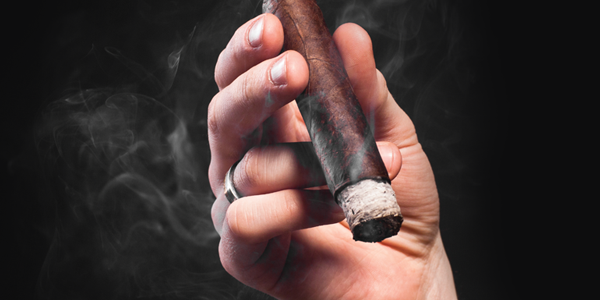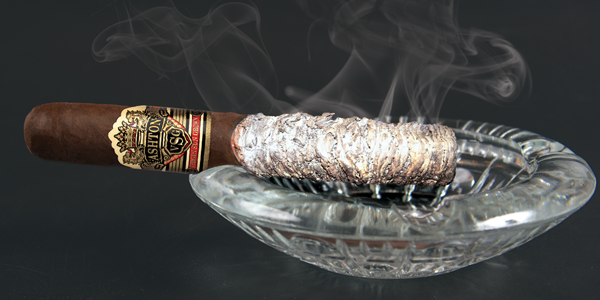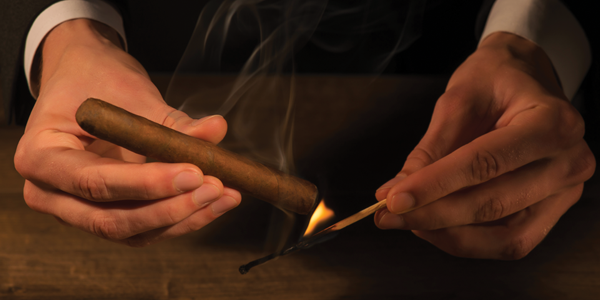What Cigar Smoke & Ash Color Can Tell You About Your Cigar
Did you ever notice that sometimes the smoke coming off the lit end of your cigar is different from the smoke you puff out? No? Are you paying attention? You, like most cigar smokers, have noticed the ash. Maybe you’re one of those who likes to keep the ash as long as possible throughout your smoke. The color of your ash, it turns out, is significant. Allow me to explain matters of smoke and ash.
Smoke Color
Occasionally, in my more contemplative moments, when I try to clear my brain of nonsense and just focus on important matters, I have noticed that smoke from the same cigar can be different colors. (Actually, I think the first time I noticed it was when I had too much to drink.) Why is this the case? And what does it mean? To find the answer, we look to SCIENCE!
Cigar smoke, or any smoke for that matter, will have its color affected by the size of the smoke particles and how they interact with light waves. The smoke particles coming off the lit end of a cigar, are really small because they have burned more, and when light hits them, the reflection is slight. There is only a slight deflection (bounce) of light called scattering. As you remember from high school science class, colors have different light wave lengths (Oh, you played hooky that day?). Better put, the waves are different sizes. If your smoke has a blue-ish tint, that’s because the smoke particles are about the same size as the light waves toward the blue, or short, end of the spectrum (remember prisms?). So, since more blue waves are scattering in the area of the smoke, you’ll see the smoke as kind of blue in color. Other longer or bigger light wave lengths go right past the small smoke particles so they do not affect the tiny smoke particles. They cause no reflection of color.
Now, the smoke that gets into your mouth when you take a puff is made up of larger smoke particles because those particles have not been burned as much as the ones coming off the lit end of your cigar. When you blow the smoke out, it looks white. That’s for a couple of reasons.
First, you have puffed those less-burned particles into your mouth and they remain bigger. Second, when you expel the smoke, those particles collect moisture on the way out and become bigger. The particles now are big enough to reflect all light waves on the spectrum and create white light, so the smoke appears white. Remember, white light is the combination of all colors.
Yeah, So What Does That All Mean?
Well, it means mostly that you probably weren’t really paying much attention in high school, but not really very much in terms of the quality of your smoking experience. It’s different with the ash.
Hey, You Got a Nice Ash!
The color of the ash essentially indicates what minerals are in the tobacco. Basically, if the ash is white (or gray-ish), the likelihood is that the tobacco was grown in very rich, nutrient-dense soil. A darker – or black – ash, indicates less mineral-rich soil. Mineral content does affect the flavor of the cigar. A general rule of thumb is that fewer minerals in the soil will produce a more acidic flavor in the cigar. That’s not particularly pleasant to taste or smell.
To be a little more precise, a bright, white ash shows that the tobacco has received enough magnesium and calcium from the soil. Cameroon tobacco, for example, used mainly as wrapper leaf, tends to burn with a bright white ash. If your white ash is flaky, that indicates too much magnesium in the soil. Cuban tobacco produces a grayer ash.
Premium cigars, meaning those made with long filler, generally produce ash that is still fairly strong, even after it burns. Cigars made with short-filler tend to make for very flaky ash.
To Ash or Not Ash
There’s a lot of talk among cigar smokers about whether and when to ash the cigar, meaning knock off the burned tobacco. You’ve seen smokers who constantly tap the cigar on the ashtray. I always ask if they smoked cigarettes before they took up cigars. A good system to follow, it seems to me, is not to tap the ash off the cigar. It’s best to lay the cigar in the bed of the ashtray and let the ash just fall off when it’s ready to do so. You’ll likely see a gap begin to develop as the ash gets to about one-inch in length.
No ash or a very short ash can sometimes contribute to a hot smoke. A longish ash, conventional wisdom has it, can help to cool the cigar smoke. Follow the one-inch rule, and you’ll likely be in good shape without having to brush all that burned magnesium off your shirt.
My preference, when ready to ash the cigar, is to roll it along the floor of the ashtray. Don’t whack the cigar on the side. If you’ve got the touch, you can also lightly tap the cigar to drop the ash.







